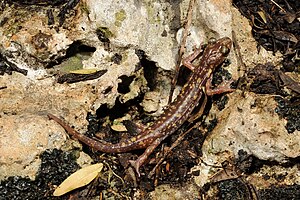Fragrant cave salamander
| Fragrant cave salamander | ||||||||||||
|---|---|---|---|---|---|---|---|---|---|---|---|---|

Fragrant cave salamander ( Speleomantes imperialis ) |
||||||||||||
| Systematics | ||||||||||||
|
||||||||||||
| Scientific name | ||||||||||||
| Speleomantes imperialis | ||||||||||||
| ( Stefani , 1969) |
The fragrant cave salamander ( Speleomantes imperialis , syn .: Hydromantes imperialis ) is a tailed amphibian from the family of the lungless salamander (Plethodontidae), which occurs in the central southeast of Sardinia in the province of Nuoro and in the east of Oristano .
features
The animals are 12 to 15 cm long and are dark brown to red-brown in color on the back with yellowish spots. The belly is light-colored. Fingers and toes are short, rounded and up to half of their length connected with tension skins. The snout is bluntly rounded. A furrow connects the lips and nose. The species is characterized by a strong smell, which also led to the common German name.
Way of life
The fragrant cave salamander occurs from sea level up to heights of about 1200 meters and lives in caves and in crevices in the karst . Above ground they are only seen in winter and after rainfall and then prefer to stay in shady, damp places under stones, tree stumps or rotten piles of wood. The animals are purely terrestrial and can swim well but climb well. Because they have no lungs, breathing occurs exclusively through the oral mucosa and the body surface. Fragrant cave salamanders feed on small insects, woodlice and spiders, which are preyed on with their sticky, quick-flinging tongue.
Reproduction
As with other cave salamanders, mating occurs on land. In the preceding courtship, the male climbs on the female and clasps it with his front legs. Then it inflicts small wounds on its back with its small teeth, into which a stimulating secretion from a gland on the male's chin is then rubbed. Then the male releases his hug and the "mating march" begins, the male first and the female behind. The male deposits a spermatophore on the ground. This seed packet is then taken up by the female with her cloaca . The female later lays 5 to 15 eggs in burrows and guards them there. The young hatch from the eggs after 6 to 11 months.
Hazard and protection
The fragrant cave salamander is classified by the IUCN as "Near Threatened" (corresponds roughly to the German category "warning list"). Like all members of the genus, the species is presumably insensitive to the chytrid fungus ( Batrachochytrium dendrobatidis ).
Phylogeny, taxonomy, systematics
The family of the Plethodonthidae is with about 362 species in 28 genera the most species-rich of the tailed amphibians, but lives almost exclusively in America. The genus Speleomantes is, besides a Korean species, the only non-American and European representative. The genus includes seven species that live in the Mediterranean region, four of which are endemic to the island of Sardinia. Within the genus, the species of the subgenus Speleomantes s. st. assigned. Alternatively, many taxonomists view Speleomantes as a subgenus of the American genus Hydromantes .
There are two subspecies:
- Speleomantes imperialis imperialis . Eastern, south-eastern and central Sardinia, in the provinces of Nuoro , Oristano and Cagliari , from sea level to a little over 1000 m.
- Speleomantes imperialis sarrabusensis Lanza, Leo, Cimmaruta, Caputo & Nascetti, 2001. Only in Sarrabus-Gerrei , in the Monte dei Sette Fratelli. The subspecies is now considered a valid species by many authors.
According to the genetic data, the species is closely related to Speleomantes supramontis (possible sister species ) , which is also endemic to Sardinia .
supporting documents
- ↑ a b c d Axel Kwet: Reptiles and Amphibians of Europe . Franckh'sche Verlagsbuchhandlung, Stuttgart 2005. ISBN 3-440-10237-8 . Page 84 and 85.
- ↑ Speleomantes imperialis in the endangered Red List species the IUCN 2009. Posted by: Franco Andreone, Roberta Lecis, Paul Edgar, Claudia Corti, Roberto Sindaco Antonio Romano, 2008. Accessed July 15 of 2019.
- ↑ Frank Pasmans, Pascale Van Rooij, Mark Blooi, Giulia Tessa, Sergé Bogaerts, Giuseppe Sotgiu, Trenton WJ Garner, Matthew C. Fisher, Benedikt R. Schmidt, Tonnie Woeltjes, Wouter Beukema, Stefano Bovero, Connie Adriaensen, Fabrizio Oneto, Dario Ottonello, An Martel, Sebastiano Salvidio (2013): Resistance to Chytridiomycosis in European Plethodontid Salamanders of the Genus Speleomantes. PLoS ONE 8 (5): e63639. doi: 10.1371 / journal.pone.0063639
- ↑ a b S. Carranza, A. Romano, EN Arnold, G. Sotgiu (2008): Biogeography and evolution of European cave salamanders, Hydromantes (Urodela: Plethodontidae), inferred from mtDNA sequences. Journal of Biogeography 35: 724-738. doi: 10.1111 / j.1365-2699.2007.01817.x
- ^ B. Lanza, C. Pastorelli, P. Laghi, R. Cimmaruta (2005): A review of systematics, taxonomy genetics, biogeography and natural history of the genus Speleomantes Dubois, 1984 (Amphibia Caudata Plethodontidae). Atti del Museo Civico di Storia Naturale di Trieste 52 (supplemento): 5-135.